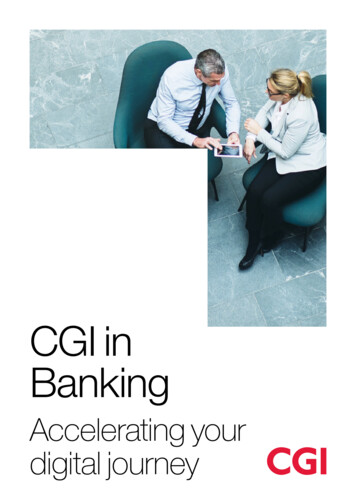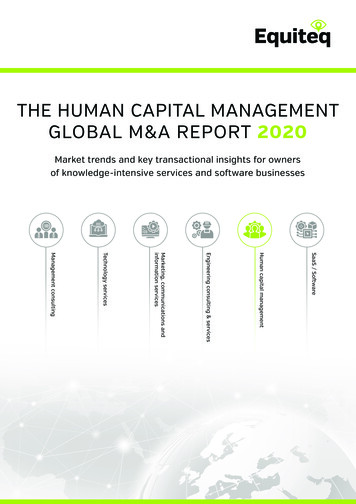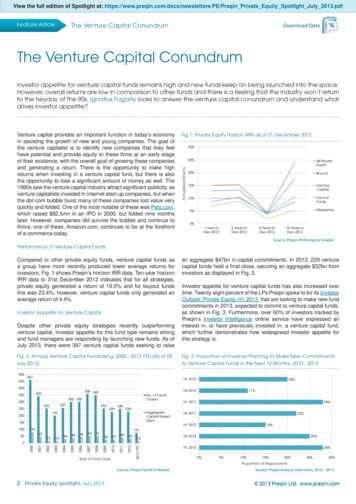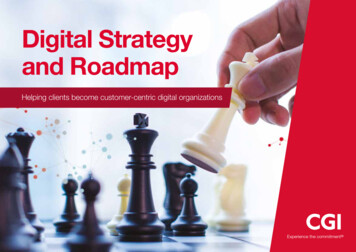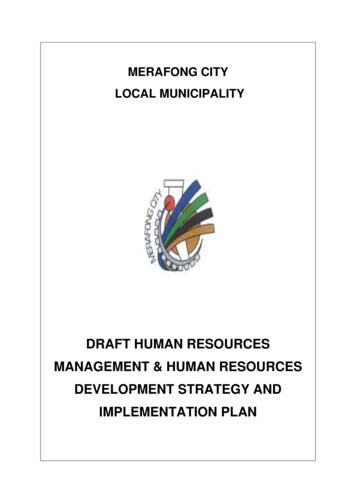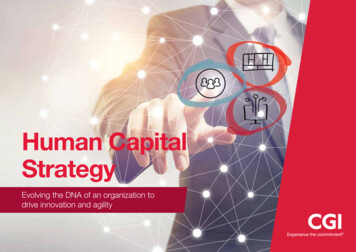
Transcription
Human CapitalStrategyEvolving the DNA of an organization todrive innovation and agility
ContentsHuman capital strategyoverview3Business drivers4Anatomy of a strategy5Human capital strategy inpractice6CGI’s structured approach8Why CGI?92
Human capital strategyoverviewOrganizations in every sector are pursuing digital transformation strategies and programs to compete in an increasingly digital-first world and evolve intodigital businesses. A key challenge, however, is driving transformation across the entire enterprise and doing so on a continuous basis in response to evolvingbusiness demands.Digital transformation involves a fundamental change to an organization’s core DNA, including how it innovates, listens to customers, empowers its employees,collaborates with partners, and delivers new products and services. It’s also about driving change across the entire enterprise—from front-end customerchannels to back-end processes and supply chains.81%of organizations saytheir biggest challengein achieving digitaltransformation centerson culture, talent andthe digital employeeSource: 2017 CGI Client GlobalInsightsThe ultimate goal is to enable an organization to become more agile in responding to evolving demands in a dynamic market. This kind of broad, fundamentalchange doesn’t have a clear start and end. It takes place continuously in response to changing market drivers, customer/citizen demands and employeeexpectations.Leading organizations are re-thinking how their workforces are built, organized and motivated to achieve continuous agile transformation. CGI helpsorganizations build digital workforces with the right mind-set and capabilities—and enabled by the right structure, leadership, management systems, cultureand partner ecosystem—to successfully embrace and drive digitalization and deliver the business outcomes required for long-term success and futurereadiness.Clusters of smaller, focused autonomousbusiness units that partner and collaborate withother business units, making decisions fasterCulture and management system thatencourages a curious mind-set,collaboration and innovationAgile ated into an ecosystem ofpartners that collaborate, share, innovate anddeliver increased value to a networked andshared economyCo-designed market opportunities,products and services informed by customerneeds and behaviorsBusinessProduct,Service,ModelDecisions made based on insights generatedfrom customer and operational dataEmployees freed up to work on value-addactivitiesDelivered by agile, simplified and frugaloperational processesTechnologyEnabled by smart, fast, integrated andautomated technology platforms and solutions368%of organizationsexecuting digitaltransformationstrategies said theirfuture decision-makingwill be at the businessunit, team or employeelevelSource: CGI Proprietary Study inResearch Partnership with IDC(2017)
Business driversA human capital strategy and roadmap focused ondelivering tangible outcomesCompanies’ organizational change focus*On average, only 16% of organizations have completed their journey to becoming adigital business for the future by transforming their operations and culture across theenterprise.*XXSimplify the way the organization is managed (68%)XXEstablish a program to build a collaboration culture within the organization(63%)XXChange recruiting and retention criteria to emphasize technology skills (61%)XXIncrease the decision-making powers of frontline employees (59%)XXAdd groups to promote innovation such as labs or garages (55%)XXMake major changes to core organization structures (51%)Acting, however, is easier said than done. Driving meaningful change across theenterprise is challenging. An organization’s DNA must change, including how it’sstructured and how it operates. As listed on the right, leading organizations are makingfocused organizational changes with the objectives of:XXCreating a digital-first cultureXXBecoming customer centric by putting the customer firstXXMoving decision-making closer to the customerXXHiring and retaining talent with the right skills and mind-setXXFacilitating quick decision-making and improving agility in response to changingdemandsXXXXnpMind-setManagerial FocusVerticalEscalations andfighting silo firesVisibleHorizontalKey IndicatorsRevenues andoperational outputDashboard andmetricsCollaborative andcontinuous improvementCost andqualityTime to market andcapacity managementDriving collaboration among internal functions and with external partnersIncreasing the speed and scale of innovationIntimacyCustomer-drivenbusiness modelUncertaintyInnovation, partnership,and agility maturity levelsw’sAn effective human capital strategy puts in place the right leadership for building aworkforce focused on the customer/citizen, empowered by collaboration and driven bya curious mind-set that leads to innovation and agility. CGI works closely with clients todefine their key business drivers and priorities and to develop a human capital strategyclosely aligned with each.*Source: CGI Proprietary Study in Research Partnership with IDC (2017)4Net promoter scoredemand managementRevenue and marketexpansion
Anatomy of a strategyIn driving organizational change, an effective human capital strategy covers a number of dimensions. Depending on an organization’s maturityand strategic objectives, key focus areas include the following:Ambition: Organizational change depends on the organization’s ambition. What does it want to become? Questions to consider include:1) Who are we? 2) Why do we exist? 3) What do we have to offer? Once an organization’s ambition is defined, its values and culture can beshaped to support that ambitionBusiness and operating models: Organizations are changing how they operate and exploring new business concepts and models. Definingthe business and operating model at key stages in the transformation will ensure the organization achieves its ambition and will also help tofacilitate clear communicationRoadmap: To fulfill its ambition, an organization needs an effective roadmap that outlines the required steps and capabilities. The roadmapshould specify when each capability is required and how long each capability will take to mature. It also should address whether a partner oroutsourcing is required to gain the capabilities and what changes to the organization’s ecosystem need to take place.Adapting to yourbusiness needsIn developing a human capitalstrategy, the right questions andoptions need to be considered.CGI helps with both. We workcollaboratively with clients to build ahuman capital strategy that coversall bases by providing the following:XXAn integrated vision androadmap for yourorganization—one that isadapted to your digital maturityand market dynamicsXXAn enterprise-wide approachthat balances customerdemand-driven agility at thefront end with the need forintegration, compliance andsecurity at the back end todeliver innovative services—anytime, anywhere, anyhowXXA forum for bringing togetherinsight and practical experienceto promote meaningful dialoguebetween the business and rienceDevelopment5
BankingBanks are responding to the urgency to transform in their industry. From appointingsenior digital executives to improving employee collaboration to undertaking acquisitionsand joint ventures around digital, the banking industry is looking at human capitalstrategies and operating models to support these transformations.According to findings from our 2017 CGI Client Global Insights, 62% of capitalmarket executives said digital capabilities are being embedded into lines ofbusiness. In addition, retail and corporate and transaction banks are partneringwith external providers to drive innovation and transformation.HealthForty-six percent of healthcare executives interviewed as part of our 2017 CGI ClientGlobal Insights said they have enterprise digital strategies, and 55% said they areextending those strategies to include ecosystem partners. Despite huge transformationefforts in the industry, 77% of organizations reported cultural change and changemanagement as a top challenge.Many are taking actions. For example, 33% are hiring digital leaders as a keytransformative initiative, 58% are improving governance, and 57% are improvingemployee collaboration.InsuranceAccording to our 2017 CGI Client Global Insights, 50% of insurersinterviewed have a digital strategy across their enterprise with a focus ontheir internal organization, and 41% are extending their enterprisestrategies to include ecosystem partners. Seventy-five percent saidcultural change and change management are still a challenge. Insurers areinvesting in innovation hubs, creating new partnerships and takingtransformative actions to empower nsAs communication service providers (CSPs) accelerate digitaltransformation, they face challenges not only around technology but withcultural change and the speed of transformation. Having the rightorganization design and workforce strategy is paramount.Findings from our 2017 CGI Client Global Insights show that 66% ofCSPs are embedding digital capabilities into lines of business and61% of organizations are undertaking transformative initiatives toprovide employees with digital tools.InsuranceCommunications6
ManufacturingRetail and consumer servicesManufacturers are accelerating their transformation, with some taking more holisticapproaches. They're taking solid steps to build agile digital businesses and empowertheir employees. In addition, they're strengthening their strategic positions within thewider ecosystem to secure the future and take advantage of new growth opportunities.For 84% of manufacturers, addressing culture, talent and digital employee issuesremains a top challenge.Many are taking actions. For example, 51% are appointing senior digitalexecutives, 57% are providing digital employee tools and 70% are takingtransformative actions to improve employee collaboration.While the retail industry continues to experience major disruptions and evolving customer demands, only22% of executives interviewed have enterprise digital strategies. Retailers are facing majortransformation challenges due to aging workforces, cultural change and legacy constraints. They needholistic digital transformation programs that invest in the organization’s structure, culture and talent,enabling innovation and collaboration to differentiate in the marketplace.According to findings from our 2017 CGI Client Global Insights, 42% are investing in hiringdigital C-levels to enable innovation, 64% are improving employee collaboration, and 49% areimproving governance.UtilitiesManufacturingEnergy andutilitiesRetail andconsumerservicesCapitalegy IncticeAs utilities realize the need to execute their digital strategies at scale and paceto compete, many are extending their digital strategies across the enterprise toinclude partners. They’re also organizing to drive their enterprise transformationroadmaps. Seventy-seven percent of respondents in our 2017 CGI Client GlobalInsights report cultural change and change management as a top challenge.Sixty-five percent are taking actions to improve employee collaboration, and64% are working to create a customer-centric culture.GovernmentMany government organizations have departmental strategies, focused onfulfilling customer expectations and improving efficiency. While they’re takingsteps to transform and innovate, they’re facing huge challenges due to culturechange and change management (91% of central and federal governments,and 84% of state and local governments). For example, only 53% of central andfederal government clients have a defined human capital strategy in place.GovernmentSixty-three percent of central and federal government and 45% ofstate and local clients are taking actions to attract and retain digitaltalent, and many are taking actions to improve employeecollaboration.Utilities7
CGI s structured approachFocusing on driving pace and scale in a dynamic marketOur principlesDifferent organizations have different levels of urgency for digital transformation, depending on the intensity of disruption in their industry.CGI helps organizations develop a holistic human capital strategy that helps them achieve the right pace and scale of transformation in adynamic market. Our approach balances the timing of changes to achieve the ambition with the delivery of a wider transformation that drivesvalue through targeted interventions and innovation initiatives.InterventionsWe base our approach on the followingprinciples:Maintain the existingbusinessTransition to a businessof the future6 months per layer of organizationInnovationsIncubate newinnovations1 year2 yearsOrganizationaland culturalchangeNewbusinessmodel3 years4-5 yearsCGI digital leaders: Through our 2017 CGI Client Global Insights and our experience in digital transformation, we have identifiedkey actions required for success. Assessing a client’s current maturity against this framework of actions identifies a number ofopportunity gaps for discussion and potential action.8XXBusiness outcome focus to ensure thedevelopment of tangible capabilitiesXXBusiness value focus to ensure financialreturns are achievedXXHypothesis driven to provide for rapidtesting and validation of optionsXXBusiness strategy alignment to identify,establish and exploit the right solutions
The framework looks at the following areas:Adopt the right organizational structure & cultureDrive change at pace and scaleEnvironmentStructureSkills and talentCollaborationCommunicationShape the business through data-driven insightDefinition and visionLeadership actionsAgility of decision-makingProcess and governanceMeasurement of performance (digital KPIs)Financial alignmentModernize delivery and invest in emerging technologiesStrategic positioningCritical InformationInnovationOperational improvementTechnology useMaturity of agile and DevOpsEmerging technology experimentationDigital factories and labsHot topicsThe market is full of thought leadershipon organizational change associated withbecoming an agile business organization.The challenge is identifying which elements tofocus on:XXCustomer centricityXXNetworked organizationsXXTeam-based performance managementXXCollaborative cultureXXHolocracyXXDesign thinkingCGI Digital Employee Experience: We look at the customer journey and then analyze how the employee journey supports this. We lookat what’s needed to drive employee engagement and productivity.XXService designXXDesigning for growthCGI Change Management: Change management is a key part of human capital strategy development. CGI performs a changereadiness assessment that involves interviews with executives, focus groups with middle management and surveys of end users(employees, customers and non-customers). The output leads to the development of a change management plan, as well as a supportingcommunications plan, that are aligned with the required organizational change and designed to ensure successful change adoption andimplementationXXLean StartupXXAgile and DevOps organizationsXXInnovation labsXXDigital factoriesOUR APPROACH IS SUPPORTED BY KEY ENABLING CAPABILITIESCGI Organizational Design Studio: We collaborate closely with the client to identify and design its target operating model and anorganizational structure to support this model. We help it evolve its organization’s structure, culture and talent to drive curiosity andinnovation and put decision-making closer to the customer. We also identify and design the required roadmap, new business combinations(partnerships, joint ventures, acquisitions, etc.) and technology for successful implementation.CGI has centers of excellence and practicesacross the globe specializing in these topicsand delivering successful transformations forclients.9
Why CGI? As one of the world’s largest independent end-to-end services firms, our combinedbusiness and technology expertise uniquely enable us to help you at every pointin your digital transformation journey, including the development of your humancapital strategy. We co-create your human capital strategy, collaborating closely with your businessand technology stakeholders. Based on our numerous acquisitions over four decades, we offer extensiveexperience and expertise in people and culture integration and a proven integrationapproach. Our experience in delivering complex, mission-critical systems across private andpublic sectors ensures any supporting systems we recommend for your humancapital strategy are realistic, effective, scalable and secure. Our starting point is your business strategy. You can be confident that our work isaligned with and informed by your business goals. We have the cross-industry expertise it takes to identify and exploit opportunities.10
Driving your digital transformationCGI helps clients achieve superior value through end-to-end digitaltransformation. Our expertise across legacy and digital environmentsuniquely enables us to support clients at every point in their digitaltransformation journey.We have the methodology and capabilities to assist clients in definingtheir digital strategy and roadmap, as well as the breadth and depth ofexperience to deliver their transformation through key digital enablers.CGI’s enterprise digital transformation capabilities and digital industryexpertise help clients embark on their digital transformation journeysand succeed in becoming customer-centric digital organizations.Learn more about our digital transformation capabilities anddigital industry expertise by visiting:cgi.com/digital-transformation, or by contacting us at info@cgi.com.11
About CGIFounded in 1976, CGI is one of the largest IT andbusiness consulting services firms in the world.Operating in hundreds of locations across theglobe, CGI professionals help clients to achieve theirgoals, including becoming customer-centric digitalorganizations. We deliver an end-to-end portfolio ofcapabilities, from high-end IT and business consultingto systems integration, outsourcing services andintellectual property solutions that help accelerateclients’ results.CGI works with clients around the world through aunique client proximity model complemented by aglobal delivery center of excellence network to helpclients accelerate results, transform their organizationsand drive competitive advantage.www.cgi.com 2017 CGI GROUP INC.
In developing a human capital strategy, the right questions and options need to be considered. CGI helps with both. We work collaboratively with clients to build a human capital strategy that covers all bases by providing the following: X An integrated vision and roadmap for your organization—one that is adapted to your digital maturity





